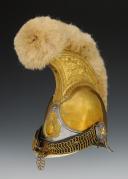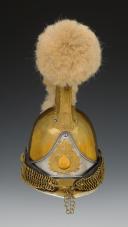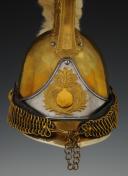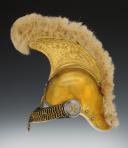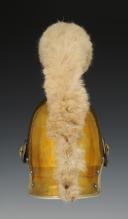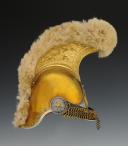
TRUMPET HELMET OF CARABINEERS OF THE IMPERIAL GUARD, model 1856, Second Empire. 27137
Sold out
TRUMPET HELMET OF CARABINEERS OF THE IMPERIAL GUARD, model 1856, Second Empire. 27137
Yellow copper bomb, stamped with a hammer into two shells joined by a staple; it is pierced at the top with two suction cup holes (diameter: 2.5 cm). It is hallmarked “DELACHAUSSÉE”, registered “690”, dated “1870”.
Visor also in copper. Its exterior curve, which has a very obtuse projecting angle in the middle, is bordered by a circle of white metal called nickel silver, placed astride, 7 mm wide on each folded face, and fixed at each end by a rivet; it is lined with glued green sheepskin and caught in the setting of the circle. This visor is assembled using five copper rivets; its width in the middle is 5 cm; its external development is 30 cm; that of its throat, near the bomb, is 26 cm; its center line is inclined 40 degrees below a plane which would pass through the connection of the bomb and the visor.
Copper neck cover, composed of two pieces:
A circular strip on its flat (apparent height, 18 mm, welded on the rear edge of the bomb which it extends; it has a development of 23 cm near the bomb and 20.5 cm at the bottom. – The second piece, welded inside and at the bottom of the first, cul-de-lampe shape (development at the top, 20.5 cm; same at the bottom, approximately 30 cm); nape forms a groove of 5 cm of chord by 7 of arrow, measured on the middle line The whole is bordered in nickel silver like the visor, and this border has 442 cm of development from the rear edge of one of the rosettes. chinstraps to the opposite one. – A black sheepskin is glued below the neck cover 4 mm inside the border are, on each side of the neck cover, three iron nails with half-spherical heads of 7 mm. in diameter and riveted inside the helmet The first is 7 mm above the first strip; the second in the middle of this strip and the third on the bottom piece 22 mm from the second.
A tin headband, stamped all around with three protruding threads, together 5 mm wide. He is an adherent of the bomb; its base rests on the visor; its height on the sides is 3 cm. In the middle it has a rounded point 10 cm high which joins the crest and which is stopped by an iron screw with a half-spherical head. The two ends of the headband are riveted to the bomb, near the chin straps.
In the middle of the headband is fixed by two hardened iron screws whose head is inside, a stamped copper attribute, representing a pomegranate surrounded by palm leaves (H of this ornament 7.5 cm; maximum width 7.2 cm).
Two chinstraps with copper wire mesh. The links, 19 in number, have the shape of a lying 8 and are attached by a 20th link in the shape of a B, to the rosette of the chin strap. The bottom of the right chin strap ends with a double copper wire hook 2.7 cm long. The one on the left is furnished with a piece of chain of 11 round copper rings (length 9.5 cm) to hold the hook. At the end of this chain is a small clip to raise the chain when the chin strap is not under the chin.
The rosettes of the chinstraps are made of tinplate, circular in shape (diameter 5.5 cm), bordered by a relief rush and stamped with rays. They are fixed to the helmet by a pivot, the head of which is a copper star (ray from the center to the tips 12 mm This threaded rod is received in a small tube serving as a bomb-welded nut and which forms a trunnion on the chin strap and its rosette.
The chinstraps are mounted on a black patent leather trim which extends under the rosette and which has a flat clasp in the middle to hold the chain.
Length of each chin strap, not including the rosette: 14 cm
Width of the 1st link: 4.5 cm
Width at the bottom: 1.7 cm
Crest made up of two fins and a mask, in yellow copper.
Each fin presents a curvilinear triangle, the base of which connects with the bomb by means of a scalloped edge, 1 to 1.5 cm, decorated with gadroons. This connection curve has 23 cm of development. The upper curve has approximately 35 cm of development from its origin on the bomb to the middle of the rounded protrusion of the crest. Finally, the interior re-entrant curve, from this same point to the bomb, has 15cm of development on 13cm of chord and 3.5 cm of arrow.
The fins are stamped in relief with an acanthus leaf frame and a laurel branch in the middle.
The mask is used to join the two fins in front to which it is welded by its edges which are decorated with nets. It ends squarely at the top and at the bottom with a cul-de-lamp which fits under the headband and which the same screw passes through. (Width of the mask at the top 4 cm; in the middle 2.5 cm; at the bottom 3 cm).
Independently of the welding with the mask, the two fins are joined together by a tin partition, welded from one to the other at half their height and on a curved development of approximately 13 cm and in addition by a covering also in tinplate welded inside the edges.
The crest is assembled on the bomb by the screw which passes through the headband and the mask as well as four similar iron screws (two per fin) placed in the edge of each fin at its two ends and received inside the bomb in nuts arched in iron.
Caterpillar in white horsehair, mounted on a steel wire. It grows from the neck cover where it is approximately 5 cm in circumference to its head which is approximately 11 cm, and which extends beyond the crest by approximately 6 cm. The iron wire forms a hook under the head of the caterpillar and towards the middle a ring by means of which the caterpillar is attached, as well as by a threaded rod which passes through the bomb below the crest from behind, in a hole practiced for this purpose. A cambered nut receives this screw rod inside the helmet. Attached to its metal core is a tin plaque dated “1870” and registered “390”.
Interior decoration consisting of a turban and a headdress.
The turban is made of cowhide in one piece. It is attached to the helmet by four iron screws, two of which are in front. These are the same ones that set the headband attribute. Their flattened half-spherical head is on the turban which these screws pass through as well as the helmet to screw into the attribute. The other two screws have their flat heads located outside the helmet, a little higher than the chinstrap pins; they pass through the bomb and the turban and are stopped on the latter by a small copper nut which is fitted there.
The headdress is made of strong, shiny black sheepskin, cut with ten wolf teeth, with a black wire slide passing through the teeth, each furnished with a metal eyelet.
France.
Second Empire.
Very good state.
Yellow copper bomb, stamped with a hammer into two shells joined by a staple; it is pierced at the top with two suction cup holes (diameter: 2.5 cm). It is hallmarked “DELACHAUSSÉE”, registered “690”, dated “1870”.
Visor also in copper. Its exterior curve, which has a very obtuse projecting angle in the middle, is bordered by a circle of white metal called nickel silver, placed astride, 7 mm wide on each folded face, and fixed at each end by a rivet; it is lined with glued green sheepskin and caught in the setting of the circle. This visor is assembled using five copper rivets; its width in the middle is 5 cm; its external development is 30 cm; that of its throat, near the bomb, is 26 cm; its center line is inclined 40 degrees below a plane which would pass through the connection of the bomb and the visor.
Copper neck cover, composed of two pieces:
A circular strip on its flat (apparent height, 18 mm, welded on the rear edge of the bomb which it extends; it has a development of 23 cm near the bomb and 20.5 cm at the bottom. – The second piece, welded inside and at the bottom of the first, cul-de-lampe shape (development at the top, 20.5 cm; same at the bottom, approximately 30 cm); nape forms a groove of 5 cm of chord by 7 of arrow, measured on the middle line The whole is bordered in nickel silver like the visor, and this border has 442 cm of development from the rear edge of one of the rosettes. chinstraps to the opposite one. – A black sheepskin is glued below the neck cover 4 mm inside the border are, on each side of the neck cover, three iron nails with half-spherical heads of 7 mm. in diameter and riveted inside the helmet The first is 7 mm above the first strip; the second in the middle of this strip and the third on the bottom piece 22 mm from the second.
A tin headband, stamped all around with three protruding threads, together 5 mm wide. He is an adherent of the bomb; its base rests on the visor; its height on the sides is 3 cm. In the middle it has a rounded point 10 cm high which joins the crest and which is stopped by an iron screw with a half-spherical head. The two ends of the headband are riveted to the bomb, near the chin straps.
In the middle of the headband is fixed by two hardened iron screws whose head is inside, a stamped copper attribute, representing a pomegranate surrounded by palm leaves (H of this ornament 7.5 cm; maximum width 7.2 cm).
Two chinstraps with copper wire mesh. The links, 19 in number, have the shape of a lying 8 and are attached by a 20th link in the shape of a B, to the rosette of the chin strap. The bottom of the right chin strap ends with a double copper wire hook 2.7 cm long. The one on the left is furnished with a piece of chain of 11 round copper rings (length 9.5 cm) to hold the hook. At the end of this chain is a small clip to raise the chain when the chin strap is not under the chin.
The rosettes of the chinstraps are made of tinplate, circular in shape (diameter 5.5 cm), bordered by a relief rush and stamped with rays. They are fixed to the helmet by a pivot, the head of which is a copper star (ray from the center to the tips 12 mm This threaded rod is received in a small tube serving as a bomb-welded nut and which forms a trunnion on the chin strap and its rosette.
The chinstraps are mounted on a black patent leather trim which extends under the rosette and which has a flat clasp in the middle to hold the chain.
Length of each chin strap, not including the rosette: 14 cm
Width of the 1st link: 4.5 cm
Width at the bottom: 1.7 cm
Crest made up of two fins and a mask, in yellow copper.
Each fin presents a curvilinear triangle, the base of which connects with the bomb by means of a scalloped edge, 1 to 1.5 cm, decorated with gadroons. This connection curve has 23 cm of development. The upper curve has approximately 35 cm of development from its origin on the bomb to the middle of the rounded protrusion of the crest. Finally, the interior re-entrant curve, from this same point to the bomb, has 15cm of development on 13cm of chord and 3.5 cm of arrow.
The fins are stamped in relief with an acanthus leaf frame and a laurel branch in the middle.
The mask is used to join the two fins in front to which it is welded by its edges which are decorated with nets. It ends squarely at the top and at the bottom with a cul-de-lamp which fits under the headband and which the same screw passes through. (Width of the mask at the top 4 cm; in the middle 2.5 cm; at the bottom 3 cm).
Independently of the welding with the mask, the two fins are joined together by a tin partition, welded from one to the other at half their height and on a curved development of approximately 13 cm and in addition by a covering also in tinplate welded inside the edges.
The crest is assembled on the bomb by the screw which passes through the headband and the mask as well as four similar iron screws (two per fin) placed in the edge of each fin at its two ends and received inside the bomb in nuts arched in iron.
Caterpillar in white horsehair, mounted on a steel wire. It grows from the neck cover where it is approximately 5 cm in circumference to its head which is approximately 11 cm, and which extends beyond the crest by approximately 6 cm. The iron wire forms a hook under the head of the caterpillar and towards the middle a ring by means of which the caterpillar is attached, as well as by a threaded rod which passes through the bomb below the crest from behind, in a hole practiced for this purpose. A cambered nut receives this screw rod inside the helmet. Attached to its metal core is a tin plaque dated “1870” and registered “390”.
Interior decoration consisting of a turban and a headdress.
The turban is made of cowhide in one piece. It is attached to the helmet by four iron screws, two of which are in front. These are the same ones that set the headband attribute. Their flattened half-spherical head is on the turban which these screws pass through as well as the helmet to screw into the attribute. The other two screws have their flat heads located outside the helmet, a little higher than the chinstrap pins; they pass through the bomb and the turban and are stopped on the latter by a small copper nut which is fitted there.
The headdress is made of strong, shiny black sheepskin, cut with ten wolf teeth, with a black wire slide passing through the teeth, each furnished with a metal eyelet.
France.
Second Empire.
Very good state.
Reference :
27137
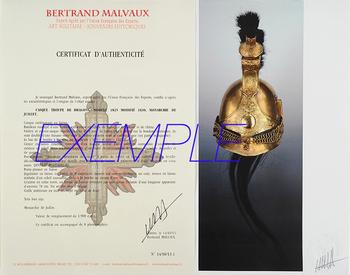
Next update Friday, may 2 at 13:30 PM
FOR ALL PURCHASES, PAYMENT IN MULTIPLE CHECKS POSSIBLE
bertrand.malvaux@wanadoo.fr 06 07 75 74 63
An authenticity certificate of the item including the description published on the site, the period, the sale price, accompanied by one or more color photographs is automatically provided for any item priced over 130 euros. Below this price, each certificate is charged 5 euros.
Only items sold by me are subject to an authenticity certificate, I do not provide any expert reports for items sold by third parties (colleagues or collectors).
